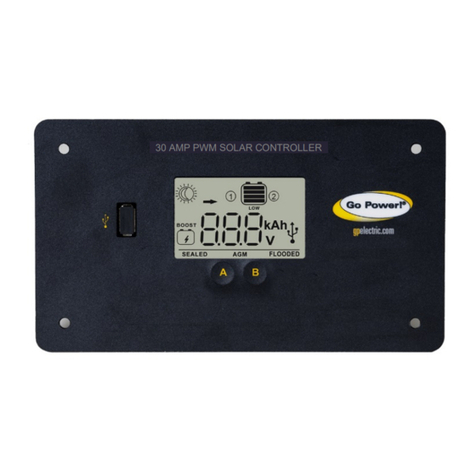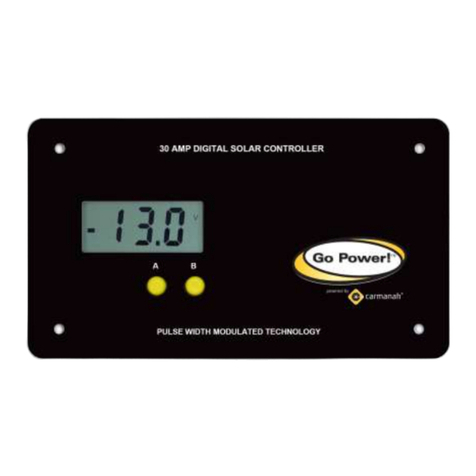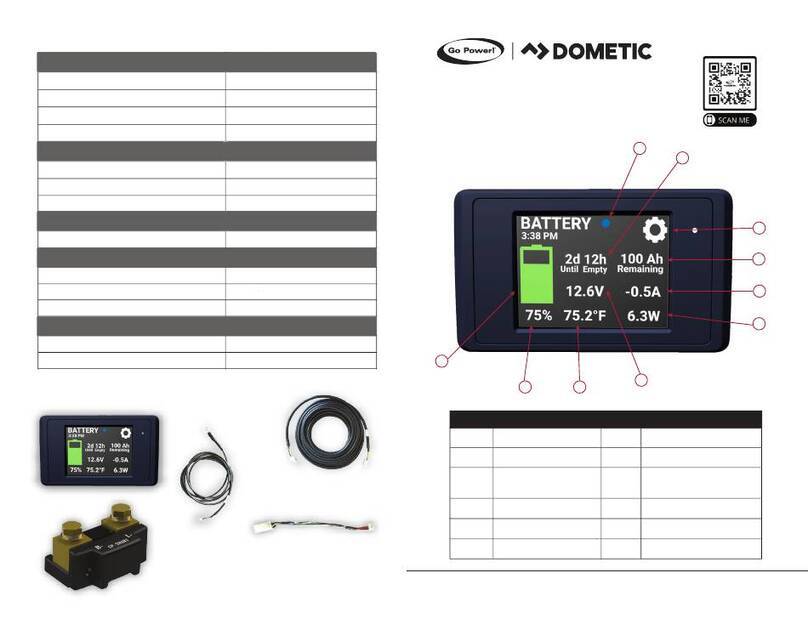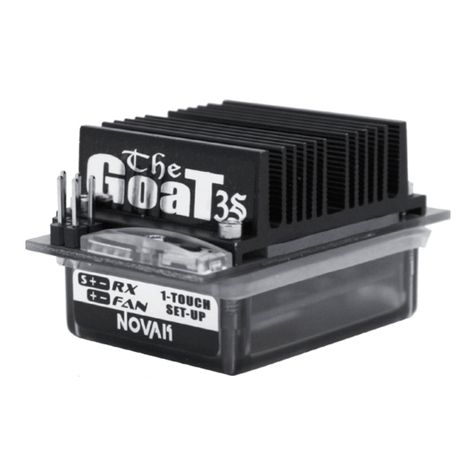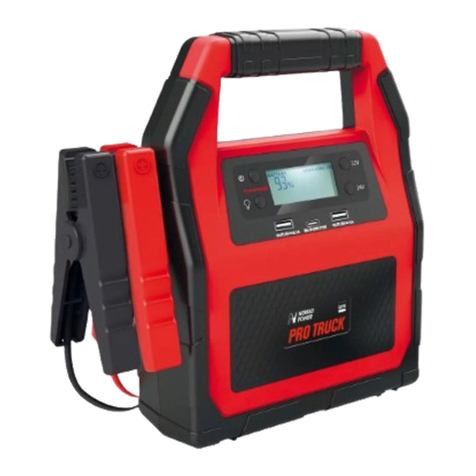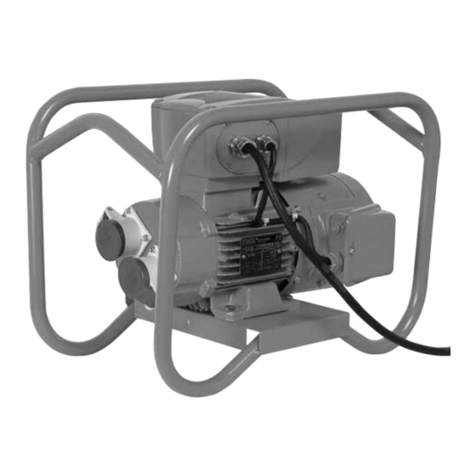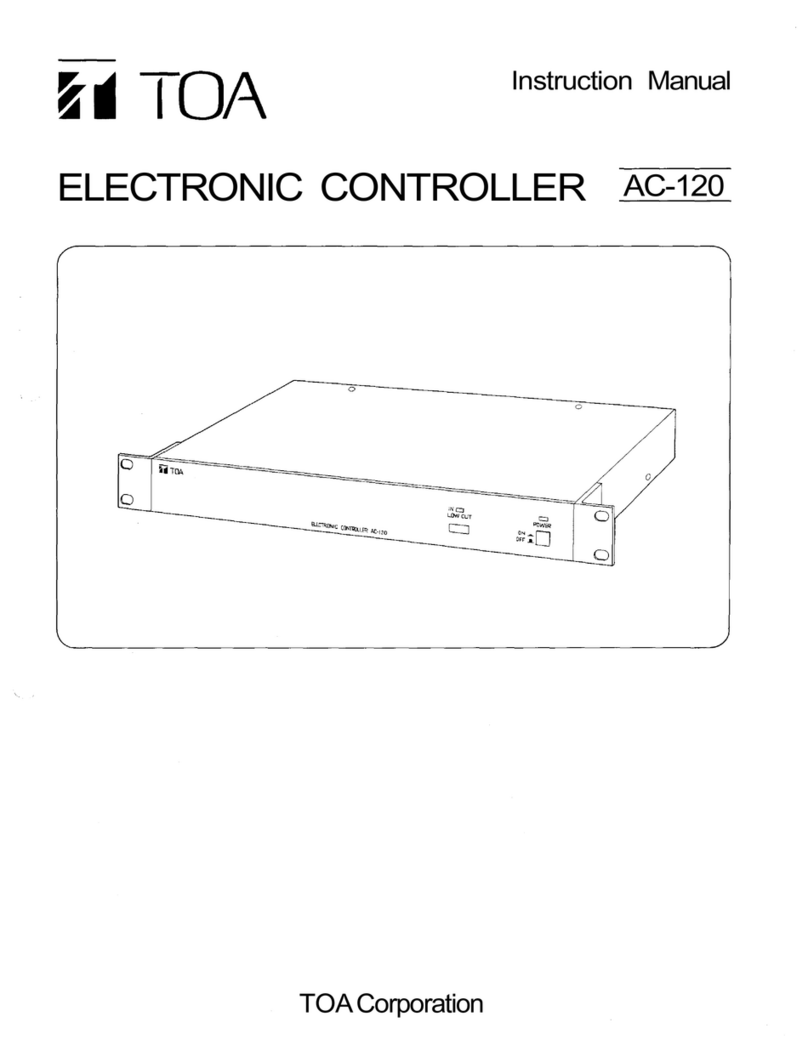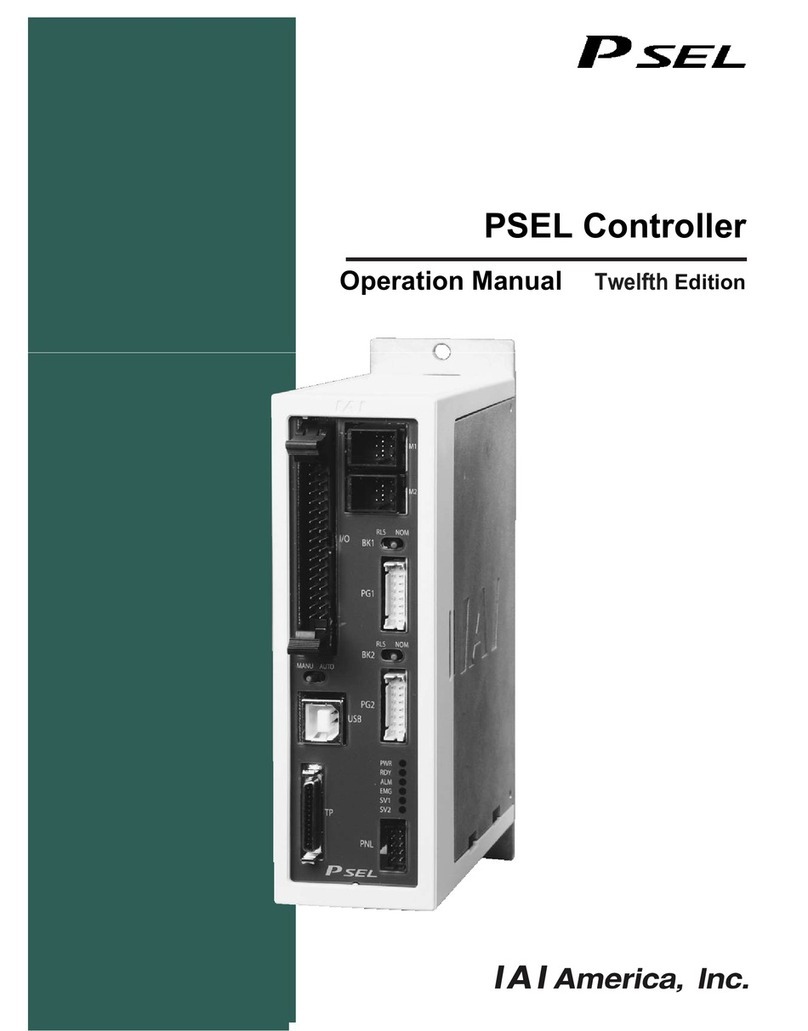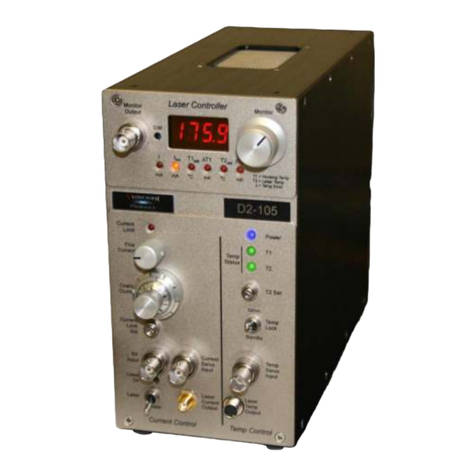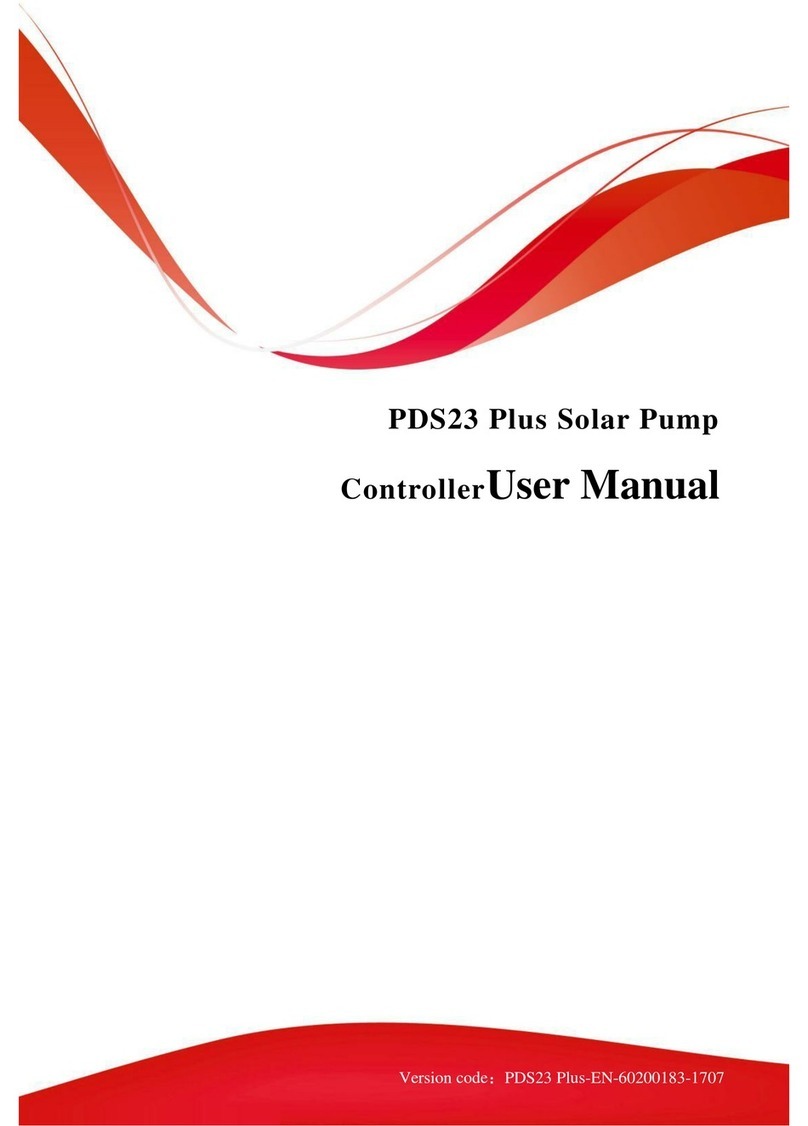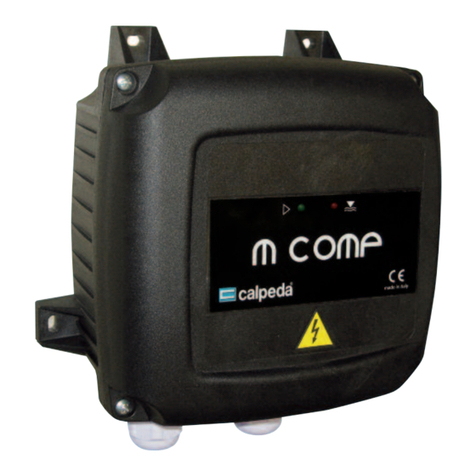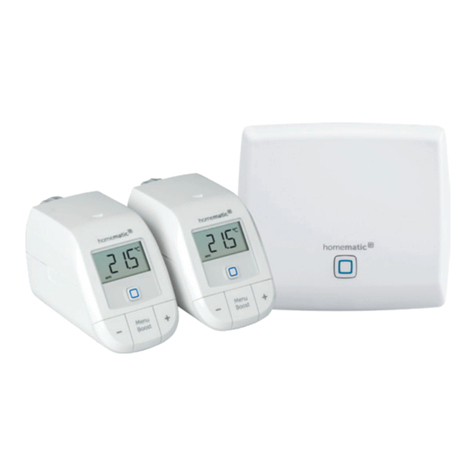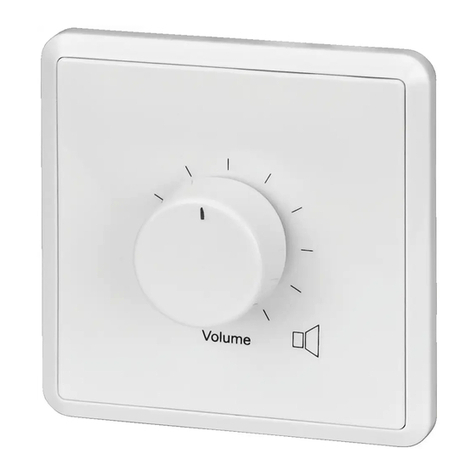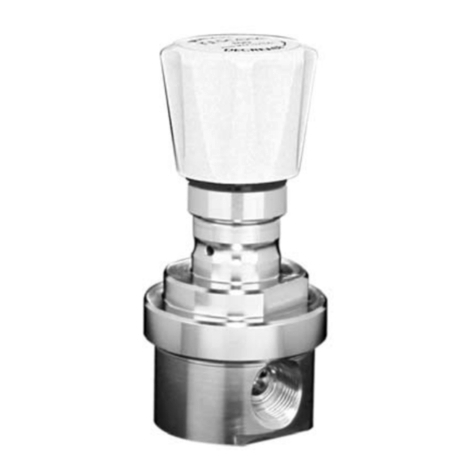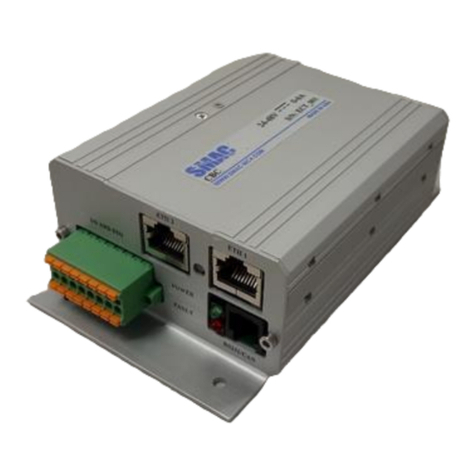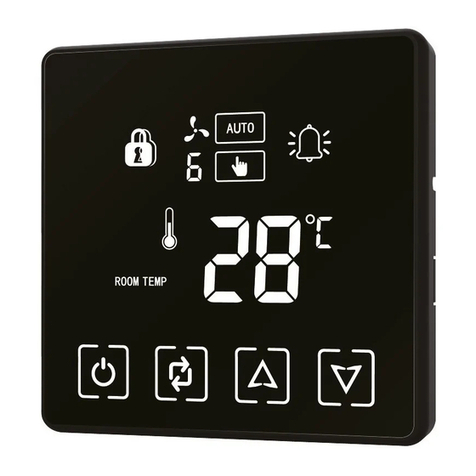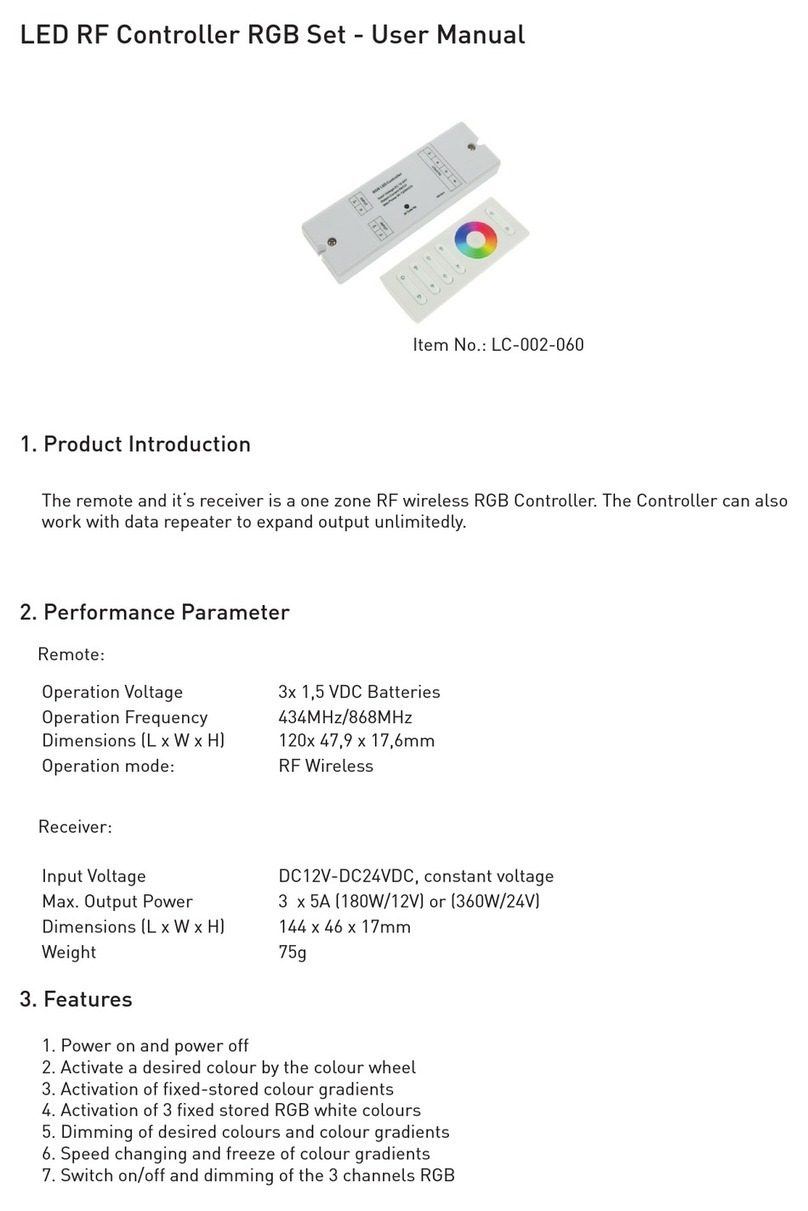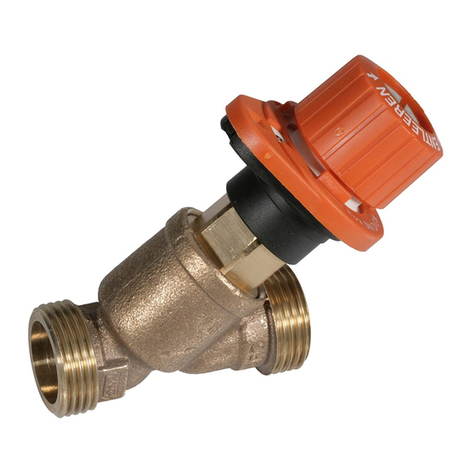Go Power GPR-25 User manual

OWNER’S MANUAL
GPR-25 Regulator


Owner’s Manual |
GPR-25 Regulator
3
Carmanah Technologies Corp. Copyright © 2007
Document number: GPR-25_Manual_v4.doc
Last revised: June 21, 2007
Table of Contents
1.0 Installation Overview..............................................................................................4
1.1 Introduction.....................................................................................................4
1.2 Specifications..................................................................................................4
2. Warnings....................................................................................................................5
3. Tools and Materials Needed.......................................................................................5
4. Choosing a Location...................................................................................................5
5. Installation Instructions...............................................................................................6
6. Operating Instructions ................................................................................................6
7. Monitoring ..................................................................................................................7
8. Normal Status Scenarios............................................................................................7
9. Before You Read Troubleshooting .............................................................................8
10. Troubleshooting Problems........................................................................................8
10.1 Problems with both Voltage & Current..................................................................8
10.2 Problems with Voltage..........................................................................................9
10.3 Problems with Current........................................................................................10
10.4 Miscellaneous Problems ...................................................................................11
11. Wiring Diagram .......................................................................................................12
12. Limited Warranty....................................................................................................13
12.1 General Warranty Issues...............................................................................13
12.2 Repair and Return Information......................................................................13
13. PHOTOVOLTAIC SYSTEM GLOSSARY ...............................................................14

Owner’s Manual | GPR-25 Regulator
4
Carmanah Technologies Corp. Copyright © 2007
Document number: GPR-25_Manual_v4.doc
Last revised: June 21, 2007
1.0 Installation Overview
1.1 Introduction
A Charge Regulator is an essential component of your photovoltaic system. The Regulator maintains the
life of the battery by protecting it from overcharging. When your battery has reached a 100% state of
charge, the Regulator prevents overcharging by limiting the current flo ing into the batteries.
The GPR-25 is a 12 volt flush mounted photovoltaic charge regulator rated for a maximum current of 25
amps. The GPR-25 features an LCD digital display that sho s solar array charge current and system
battery voltage. An LED bar graph sho s the battery state of charge.
1.2 Specifications
Description Value Dimensions (H x W x D):
Nominal Voltage 12 V 107.95 x 190.5 x 19 mm
Rated Current, Continuous Array Isc 25 A 4.25 x 7.5 x 1.6 in
Array Voltage, Max Voc 26 V
Quiescent Current 20 mA Hardware: #8/32
Current Consumption, Charging Typ. 20 mA
Voltage Drop, Array to Battery, Typ. 0.8 V Weight: 172 grams
Charge Termination Selectable 14.1 / 14.4 ± 0.2 V 6 ounces
Charge Resumption 13.0 ± 0.3 V
Operating Temperature Range -40 to 85 ° C Fuse: 25 Amp AGC
-40 to 185 ° F
LCD Operating Temperature -10 to 55 ° C Max Wire Gauge: #8 AWG
14 to 131 ° F
Display Accuracy 2 Points Warranty: 5 Years
One convenient display
alternates bet een
voltage and current
(amperage) readings
Digital display
sho s real time
battery voltage and
charge current
Coloured LED Bar
Graph sho s
battery state of
charge
Lo po er
consumption at
20 mA
All lights are
LEDs and ill
never burn out.
Full solid
state
charge
control
Charging light indicates
hen solar
modules are
charging the battery
Over current
protection
25 A Isc
charge
current
rating
Reverse
polarity
protection
5 year
arranty
Jumper setting for
sealed or flooded
batteries
Blocking diode
prevents reverse
current flo

Owner’s Manual | GPR-25 Regulator
5
Carmanah Technologies Corp. Copyright © 2007
Document number: GPR-25_Manual_v4.doc
Last revised: June 21, 2007
2. Warnings
Disconnect all power sources before attempting installation. Electricity can be very
dangerous. Installation should be performed only by a licensed
electrician or qualified personnel.
Battery and wiring sa ety. Observe all safety precautions of the battery manufacturer hen
handling or orking around batteries. When charging, batteries may
produce hydrogen gas, hich is highly explosive. Work only in a ell
ventilated area and use caution hen making or removing electrical
connections. Ensure ires are disconnected from their po er sources
hen iring. Do not expose battery to open flame, cigarettes, or sparks.
Shield skin and eyes from battery acid.
Wiring connections. Ensure all connections are tight and secure. Loose connections may
generate sparks.
Work sa ely. Wear protective eye ear and appropriate clothing during installation.
Use extreme caution hen orking ith electricity and hen handling
and orking around batteries.
Observe correct polarity Any contact in reverse polarity, ho ever brief, ill cause the
at all times. regulator fuse to blo and may damage the unit.
Do not exceed the GPR-25 The current rating of the solar system is the sum of the short Current
and Voltage circuit currents (Isc) of the solar modules in parallel. The ratings
resulting system Isc current is not to exceed 25 A. The voltage
of the array is the rated open circuit voltage (Voc) of the solar module
and is not to exceed 26 V. If your solar system exceeds these ratings,
contact your dealer for a suitable regulator alternative.
3. Tools and Materials Needed
Drill ith 3/32” and 3/8 bits UV Wire (Module(s) to GPR-25)*
Keyhole or Jigsa Battery Wire (GPR-25 to Battery)*
Phillips Scre driver Wire Cutters
#8 Flat Washers Wire Strippers
Pencil or Marking Implement Electrical Tape
* If the GPR-25 Charger Controller as purchased ith a Go Po er! Electric RV Solar Kit then UV resistant
ire is included. For instructions regarding RV Charger Kit installation, please refer to the RV Charger Kit
Installation Guide provided ith the Kit.
4. Choosing a Location
The GPR-25 is designed to be mounted flush against a all, out of the ay and easily visible.
The GPR-25 should be:
• mounted as close to the battery as possible.
• mounted on a vertical surface to optimize cooling of the unit.
• indoors, protected from the eather.
In an RV, the most common regulator location is above the refrigerator. The ire from the solar modules
most commonly enters the RV through the fridge vent on the roof. Solar connections should connect
directly to the regulator. Battery connections should connect directly from the regulator to the batteries.
Do not tie the regulator wiring in with the re rigerator wiring or any other DC wiring.
If the flush mount option is not used, ensure that the optional knockout box (Model: GPR-25-KBox) is
securely mounted to the all before proceeding ith the installation of the GPR-25 Regulator.

Owner’s Manual | GPR-25 Regulator
6
Carmanah Technologies Corp. Copyright © 2007
Document number: GPR-25_Manual_v4.doc
Last revised: June 21, 2007
5. Installation Instructions
1. Prepare or mounting. Use the template provided at the end of the manual to mark the four
mounting holes and the “cutting line for flush mounting”.
2. Complete the installation o the solar modules. If this GPR-25 as purchased as part of a Go
Po er! Electric Solar Kit, follo the RV Installation Guide provided. Other ise follo manufacturer’s
instructions for module mounting and iring.
3. Select wire type and gauge. If this GPR-25 as purchased as part of a Go Po er! Electric Solar Kit,
appropriate ire type, gauge, and length is provided. Please continue to Section 6, “Operating
Instructions”. If the GPR-25 as purchased separately, follo the instructions included here.
Wire type is recommended to be a stranded copper UV resistant ire. Wire fatigue and the likelihood of a
loose connection are greatly reduced in stranded ire compared to solid ire. Wire gauge should be able
to sustain rated current as ell as minimizing voltage drop.
Suggested Minimum Wire Gauge
(Cable length 25 ft max. from solar array to battery bank)
50 Watt #14 Wire Gauge
80 Watt #12 Wire Gauge
115 Watt #10 Wire Gauge
160 Watt #10 Wire Gauge
240 Watt #10 Wire Gauge
IMPORTANT: Identify the polarity (positive and negative) on the cable used for the battery and solar
module. Use colored ires or mark the ire ends ith tags. A reverse polarity contact, ho ever brief,
ill blo the regulator fuse and may damage the unit.
4. Jumper setting or sealed or looded batteries. Refer to the iring schematic.
5. Wiring the GPR-25. Wire the GPR-25 according to the iring schematic. Run ires from the solar
modules and the batteries to the location of the GPR-25. Keep the solar module(s) covered ith an
opaque material until all iring is completed.
Connect the battery iring to the regulator first and then connect the battery iring to the battery.
The regulator should no be sho ing the battery voltage. Connect the solar iring to the regulator
and remove the opaque material from the solar module(s). The negative solar array and battery
iring must be connected directly to the regulator for proper operation.
Do not connect the negative solar array or negative battery regulator iring to the chassis of the
vehicle.
6. Mounting the GPR-25. Mount the GPR-25 to the all using the included four mounting scre s. Place
ashers bet een the all and the back of the faceplate to create a gap that provides airflo to the
back of the unit.
Congratulations, your controller should no be operational. If the battery po er is lo and the solar
modules are producing po er, your battery should begin to charge.
6. Operating Instructions
When connected to solar modules and batteries, the GPR-25 ill automatically begin to function. It ill
regulate and monitor the battery state of charge. No further user intervention is necessary. The LCD
monitor ill cycle bet een array current and battery voltage.

Owner’s Manual | GPR-25 Regulator
7
Carmanah Technologies Corp. Copyright © 2007
Document number: GPR-25_Manual_v4.doc
Last revised: June 21, 2007
7. Monitoring
Charging LED (red): When the battery is charging, the charging light ill be lit. When the state of
charge for the battery is close to full, the light ill be off for short periods of time and on for short periods
of time - the pulse-charging feature of the GPR-25. In situations here outside ambient light is shining on
the solar module, it may be possible for the charging light to be on after the sun has set.
LCD Display: The LCD display ill cycle bet een solar array charge current and battery voltage readings,
as indicated by the green LED on the left of the display. The meter is accurate to ithin ± 2 points.
Note: Charge Termination: The charge termination of the regulator is accurate to less than 1/10 (0.1)
of a volt most of the time. Due to varying reasons the regulator may briefly overshoot the termination
point by a maximum of 2/10 (0.2) of a volt. The on/off charging nature of the regulator means that even
if the charge voltage is terminated slightly higher than the termination point, sealed batteries ill not
sustain enough current to cause any overcharging or damage.
Battery Charge Monitor LEDs (green, yellow, red): These are a graphical representation of a
battery’s state of charge during the charging cycle. When the far right green LED is blinking, the batteries
are almost full. Yello indicates that the batteries are belo 12.0 V, and that the loads should be turned
off. Red indicates the voltage has fallen belo 10 V and the battery is dead. Disregard the bar graph
reading if the battery is disconnected.
8. Normal Status Scenarios
These are all normal operating conditions. For abnormal conditions, consult the “Troubleshooting
Problems” portion of the Troubleshooting section.
Voltage Reading: 9.5 V - 11.5 V Charge Light: ON
Current Reading: 1 A – 25 A Time o Day: Daytime
Status: Battery is lo . Regulator is charging the battery.
Remedy: Minimize loads on the battery. If available, charge the battery ith alternate sources such as
the RV alternator or a generator.
Voltage Reading: 9.5 V - 11.5 V Charge Light: OFF
Current Reading: 0 A Time o Day: Nighttime
Status: Battery is lo . Regulator is NOT charging the battery.
Remedy: Minimize loads on the battery. If available, charge the battery ith alternate sources such as
the RV alternator or a generator.
Voltage Reading: 12 V – 14 V Charge Light: ON
Current Reading: 1 A – 25 A Time o Day: Daytime
Status: Battery is charging.
Remedy: None required. Battery is fine and charging.
Voltage Reading: 13 V – 14 V Charge Light: OFF
Current Reading: 0 A Time o Day: Daytime
Status: Battery is full or almost full.
Remedy: None required.
Voltage Reading: 11.5 V – 14 V Charge Light: OFF
Current Reading: 0 A Time o Day: Nighttime
Status: Battery is fine
Remedy: None required.

Owner’s Manual |
GPR-25 Regulator
8
Carmanah Technologies Corp. Copyright © 2007
Document number: GPR-25_Manual_v4.doc
Last revised: June 21, 2007
9. Before You Read Troubleshooting
Before a problem is suspected ith the system, read this section. There are numerous events that may
appear as problems but are in fact perfectly normal.
My regulator has been charging/not charging or quite a while now.
The regulator is designed to keep the batteries state of charge at full hile protecting them from
overcharging. This means that hen the voltage of the battery falls under approximately 13.0 V, the
regulator starts charging and doesn’t stop until the voltage exceeds approximately 14.1V / 14.4 V. When
the regulator stops charging at 14.1/14.4 volts, the unit ill ait until the voltage drops to approximately
13 volts before it starts charging again. If the unit is not charging but sho s a voltage bet een 12.7 and
14.4 volts, the unit is operating normally.
It seems like my looded batteries are losing water over time.
Flooded batteries may need to have distilled ater added periodically to replace fluid loss during charging.
Excessive ater loss during a short period of time indicates the possibility of overcharging or aging
batteries.
When charging, my looded batteries are emitting gas.
During charging, hydrogen gas is generated ithin the battery. The gas bubbles stir the battery acid
allo ing it to receive a more full state of charge.
My voltmeter shows a di erent reading than the LCD display
The meter value on the LCD display is an approximate reading intended for indication purposes only.
There is an approximate t o digit or 0.2 volt inherent error present that may be accentuated hen
compared ith readings from another voltmeter.
There may be a slight difference bet een the battery voltage displayed on the LCD screen and the battery
voltage measured at the battery terminals. When troubleshooting using a voltmeter, check both the
battery voltage at the regulator battery terminals and battery voltage at the battery terminals. If a
difference of more than 0.5 Volts is noted, this indicates a large voltage drop possibly caused by long
iring runs, small ire gauge, faulty iring, a faulty voltmeter or all the above. Consult the Suggested
Minimum Wire Gauge chart in section five for iring suggestions and check all connections.
10. Troubleshooting Problems
How to read this section
Troubleshooting Problems is split into six sub-sections, grouped by symptoms involving key components.
Components considered irrelevant in a diagnosis are denoted ‘Not Applicable’ (N/A). A multimeter may be
required for some procedures listed.
It is imperative all electrical precautions stated in the Warning Section and outlined in the Installation
Section are follo ed. Even if it appears the system is not functioning, it should be treated as a fully
functioning system generating live po er.
10.1 Problems with both Voltage & Current
Voltage Reading: Blank Charge Light: N/A
Current Reading: Blank Time o Day: Daytime/Nighttime
Possible Cause:
(1) Battery or fuse connection and/or solar array connection (Daytime only).
(2) Battery or fuse connection (Nighttime only).
(3) Defective GPR-25.
How to tell:
(1) & (2) Check the voltage at the regulator terminals labeled ‘Battery’ ith a multimeter and compare
ith a reading at the battery terminals.
If there is no reading at the regulator terminals, the problem is in the iring bet een the battery and the
regulator. For array, repeat step substituting all battery terminals ith array terminals.

Owner’s Manual |
GPR-25 Regulator
9
Carmanah Technologies Corp. Copyright © 2007
Document number: GPR-25_Manual_v4.doc
Last revised: June 21, 2007
Remedy:
(1) & (2) Check the fuse. Check all connections from the regulator to the battery including checking for
correct ire polarity. Check that all connections are clean, tight, and secure.
Voltage Reading: 9 V – 12 V Charge Light: Off
Current Reading: 0 A Time o Day: Daytime
Possible Cause:
(1) Battery or fuse connection
(2) Defective GPR-25.
How to tell:
(1) Check the voltage at the regulator terminals labeled ‘Battery’ ith a multimeter and compare ith a
reading at the battery terminals. If there is no reading at the regulator terminals, the problem is
some here in the iring from the battery to the regulator.
Remedy:
(1) Check the fuse. Check all connections from the regulator to the battery including checking for correct
ire polarity. Check that all connections are clean, tight, and secure.
10.2 Problems with Voltage
Voltage Reading: Inaccurate Charge Light: N/A
Current Reading: N/A Time o Day: Daytime/Nighttime
Possible Cause:
(1) Battery or fuse connection
(2) Excessive voltage drop from batteries to regulator.
(3) Incorrect calibration of the voltage meter.
How to tell:
(1) Check the voltage at the regulator terminals labeled ‘Battery’ ith a multimeter and compare ith a
reading at the battery terminals. If there is a voltage discrepancy of more than 0.5 V, there is an
excessive voltage drop
Remedy:
(1) Check the fuse. Check all connections from the regulator to the battery including checking for correct
ire polarity. Check that all connections are clean, tight, and secure. Shorten the distance from the
regulator to battery or obtain larger gauge ire. It is also possible to double up the existing gauge
ire (i.e. t o ire runs) to simulate a larger gauge ire.
Voltage Reading: Erratic Charge Light: N/A
Current Reading: N/A Time o Day: Daytime/Nighttime
Possible Cause:
(1) Battery or fuse connection
(2) Electric noise.
Remedy:
(1) Check fuse. Check all connections from the regulator to the battery including checking for correct ire
polarity. Check that all connections are clean, tight, and secure.
(2) Electric noise from other electronics such as inverters or fluorescent lights may affect the current
reading. Attempt to trace the problematic appliance and fix the problem by relocation.

Owner’s Manual |
GPR-25 Regulator
10
Carmanah Technologies Corp. Copyright © 2007
Document number: GPR-25_Manual_v4.doc
Last revised: June 21, 2007
10.3 Problems with Current
Voltage Reading: N/A Charge Light: N/A
Current Reading: Less than expected Time o Day: Daytime
Possible Cause:
(1) Wrong series/parallel configuration and/or iring connections and/or ire gauge.
(2) Dirty or shaded module or lack of sun.
(3) Blo n diode in solar module hen t o or more modules are connected in parallel.
How to tell:
(1) Check that the modules and batteries are configured correctly. Check all iring connections.
(2) Modules look dirty, overhead object is shading modules or it is an overcast day in hich a shado
cannot be cast. Note: Avoid any shading no matter ho small. An object as small as a broomstick
held across the solar module may cause the po er output to be cut to almost nil. Overcast days may
also cut the po er output of the module to almost nil.
(3) Disconnect one or both array ires from the regulator. Take a voltage reading bet een the positive
and negative array ire. A single 12 volt module should have an open circuit voltage bet een 18 and
22 volts. If you have more than one module, you ill need to conduct this test bet een the positive
and negative terminals of each module junction box ith either the positive or negative ires
disconnected from the terminal.
Remedy:
(1) Reconnect in correct configuration. Tighten all connections. Check ire gauge and length of ire run.
Refer to Suggested Minimum Wire Gauge in section 5.
(2) Clean modules, clear obstruction or ait for conditions to clear.
(3) If the voltage of a non-connected module (open circuit) is lo er than 15 volts, contact the
manufacturer.
Voltage Reading: N/A Charge Light: N/A
Current Reading: Zero Time o Day: Daytime
Possible Cause:
(1) Wrong series/parallel configuration and/or iring connections.
(2) Shaded module or overcast conditions.
(3) Blo n diode in module.
How to tell:
(1) Check that modules and batteries are configured correctly and the negative solar and battery ires
are connected directly to the regulator. Check all iring connections
(2) An object is shading modules or it is an overcast day in hich a shado cannot be cast.
(3) Disconnect one or both array ires from the regulator. Take a voltage reading bet een the positive
and negative array ire. A 12 volt module should have an open circuit voltage bet een 18 and 22
volts. If you have more than one module, you may need to conduct this test bet een the positive
and negative terminals of each module junction box ith either the positive or negative ires
disconnected from the terminal.
Remedy:
(1) Reconnect in correct configuration. Tighten all connections.
(2) Clear obstruction or ait for conditions to clear.
(3) If the voltage of a non-connected module (open circuit) is lo er than 15 volts, contact the
manufacturer
Voltage Reading: N/A Charge Light: N/A
Current Reading: Erratic Time o Day: N/A
Possible Cause:
(1) Battery or fuse connection.
(2) Electric noise.

Owner’s Manual | GPR-25 Regulator
11
Carmanah Technologies Corp. Copyright © 2007
Document number: GPR-25_Manual_v4.doc
Last revised: June 21, 2007
Remedy:
(1) Check fuse. Check all connections from the regulator to the battery.
(2) Electric noise from other electronics such as inverters or florescent lights may affect the current
reading. Attempt to trace the problematic appliance and fix the problem by relocation.
Voltage Reading: N/A
Current Reading: Rapidly changing
Possible Cause:
(1) Battery is full, array is producing full current, and there are functioning loads connected. This is
normal.
(2) The battery is too old or going bad and is unable to hold a charge.
(3) Poor battery or array connection.
How to tell:
(1) & (2) & (3) Check the voltage at the terminals ith a multimeter.
(3) Check all iring connections.
Remedy:
(1) & (2) If the voltage on the multimeter is rapidly increasing and decreasing, the battery is going bad,
the battery bank is too small, or this is a normal condition. Unfortunately, there is no ay to differentiate.
Possible solutions are to test, individually, the physical battery status using a hydrometer. Consult your
battery manufacturer’s manual for more information.
(3) If the voltage on the multimeter is stable hile the current reading is behaving erratically, it is the
battery connection bet een the battery and regulator. Check connections.
(3) Reconnect iring correctly.
10.4 Miscellaneous Problems
Status: Charge light blinking hen fuse is touched
Possible Cause:
(1) Fuse is loose.
Remedy:
(1) Securely attach fuse.
Status: GPR-25 buzzing
Possible Cause:
(1) Bad battery, array or fuse connection.
Remedy:
Check all connections and reconnect correctly.
Status: GPR-25 face plate hot to touch
Possible Cause:
(1) Defective GPR-25.
Note: It is normal for the faceplate to get arm during operation. The symptom of a defective GPR-25 is
only hen then unit gets too hot to touch.

Owner’s Manual | GPR-25 Regulator
12
Carmanah Technologies Corp. Copyright © 2007
Document number: GPR-25_Manual_v4.doc
Last revised: June 21, 2007
11. Wiring Diagram

Owner’s Manual | GPR-25 Regulator
13
Carmanah Technologies Corp. Copyright © 2007
Document number: GPR-25_Manual_v4.doc
Last revised: June 21, 2007
12. Limited Warranty
1. Carmanah arrants the GPR-25 for a period of five (5) years from the date of shipment from its
factory. This arranty is valid against defects in materials and orkmanship for the five (5) year
arranty period. It is not valid against defects resulting from, but not limited to:
• Misuse and/or abuse, neglect or accident.
• Exceeding the unit’s design limits
• Improper installation, including, but not limited to, improper environmental protection and
improper hook-up
• Acts of God, including lightning, floods, earthquakes, fire, and high inds
• Damage in handling, including damage encountered during shipment
2. This arranty shall be considered void if the arranted product is in any ay opened or altered. The
arranty ill be void if any eyelet, rivets, or other fasteners used to seal the unit are removed or
altered, or if the unit’s serial number is in any ay removed, altered, replaced, defaced, or rendered
illegible
12.1 General Warranty Issues
Please refer to the manufacturers’ arranty sheet(s)
1. Carmanah cannot assume responsibility for any damages to any system components used in
conjunction ith Carmanah products nor for claims for personal injury or property damage resulting
from the use of Carmanah products or the improper operation thereof or consequential damages
arising from the products or use of the products.
2. Carmanah cannot guarantee compatibility of its products ith other components used in conjunction
ith Carmanah products, including, but not limited to, solar modules, batteries, and system
interconnects, and such loads as inverters, transmitters, and other loads hich produce “noise” or
electromagnetic interference, in excess of the levels to hich Carmanah products are compatible.
3. Warranty repair and/or evaluation ill be provided only at the Victoria, British Columbia facility of
Carmanah. Units for such repair and/or evaluation must be returned freight prepaid to Carmanah ith
a ritten description of any apparent defects. Carmanah ill not be required at any time to visit the
installation site herein Carmanah products are subject to arranty repair and/or evaluation.
4. Only Carmanah is authorized to repair any of its products, and they reserve the right to repair or
replace any unit returned for arranty repair. The party returning a unit for repair is responsible for
proper packaging and for shipping and insurance charges, as ell as any other charges encountered, in
shipping to and from Carmanah.
5. The purchaser’s exclusive remedy for any and all losses or damages resulting from the date of sale of
this product including, but not limited to, any allegations of breach of arranty, breach of contract,
negligence or strict liability, shall be limited, at Carmanah option, to either the return of the purchase
price or the replacement of the particular product for hich claim is made and proved. In no event
shall Carmanah be liable to purchaser or purchaser’s customers or to anyone else for any punitive,
special, consequential, incidental or indirect losses or damages resulting from the sale of the product,
hether based upon loss of good ill, lost profits, ork stoppages, impairments of other goods, breach
of contract, or other ise.
6. This arranty supersedes all other arranties and may only be modified by statement in riting,
signed by Carmanah.
7. Warranty terms effective as of January 2, 2004.
12.2 Repair and Return Information
To return items:
1. Call your Carmanah dealer or Carmanah’s technical SUPPORT (1-800-667-6527) to try and
troubleshoot the problem.
2. Obtain an RMA # by calling your Carmanah sales representative or the RMA department
3. Ensure the RMA # is clearly visible on the outside of the package, or THE PACKAGE WILL BE
REFUSED.
4. Ship to Carmanah Victoria PREPAID at the follo ing address:
Carmanah Technologies

Owner’s Manual |
GPR-25 Regulator
14
Carmanah Technologies Corp. Copyright © 2007
Document number: GPR-25_Manual_v4.doc
Last revised: June 21, 2007
Building 4, 203 Harbour Road
Victoria, British Columbia
Canada V9A 3S2
5. Ensure the product is not shipped collect, unless approved by management prior to Carmanah
receiving said product, or THE PACKAGE WILL BE REFUSED.
6. Test items or items that are not under arranty, or units that are not defective, ill be charged a
minimum bench charge of ($50.00 US) plus taxes and shipping.
7. A 15% restocking charge ill be applied on goods returned and accepted as “ne ” stock.
13. PHOTOVOLTAIC SYSTEM GLOSSARY
Ampere: A unit of electrical current. Designates the number of electrons flo ing per second through a
conductive material.
Ampere-Hour (Ahr): A unit of energy, typically referring to battery capacity. One ampere of current
flo ing for one hour.
Azimuth o the Sun: The angular measure bet een due south and the point on the horizon directly
belo the sun.
Array: A number of photovoltaic modules electrically connected to produce a single electrical output.
Angle o Incidence: The angle bet een a ray of sunlight striking a surface and a line perpendicular to
that surface. Rays perpendicular to a surface have a zero angle of incidence.
Battery: T o or more electrochemical cells connected to provide energy storage.
May be used to designate one cell. PV system batteries may be “sealed” or “ et acid”.
Blocking Diode: A diode application that prevents a battery from discharging through the array at night
or if the array becomes shaded. Most charge controllers are equipped ith a blocking diode.
Charge Controller: The PV system component that controls the battery’s state of charge. It may also
provide other system control functions.
Charge Rate: The current applied to a battery to restore its energy capacity. The battery manufacturer
ill usually have a recommended charge rate for their product. The rate is typically 10 –20 percent of the
amp hour capacity at the 20-hour rate.
Current: DC or Direct Current is the type of electron flo provided by a battery or solar cell, hich flo s
in one direction. The unit for current is ampere or amp for short and designated by the letter I.
Cycle One battery cycle equals one discharge and one charge.
Deep Cycle Battery: Batteries that are designed to discharge as much as 80% of their capacity as
opposed to engine-starting or “shallo cycle” batteries hich are designed for heavy cranking but ill not
stand up to repeated deep discharges.
Depth o Discharge: A measure of ho much energy has been ithdra n from a battery, expressed as
a percentage of full capacity. A 100 Ahr battery from hich 30 Ahr has been ithdra n has undergone a
30% depth of discharge (DOD). This term is the inverse of state of charge (SC); the example battery
ould be at 70% SC.
Diode: A semi-conductor device that allo s current to flo in one direction only.
Equalization: The process that equalizes the specific gravity of all the cells in a battery by means of a
controlled overcharge that breaks do n sulfation on the battery plates. Most inverter/chargers and some
charge controllers are equipped ith this feature.
Grid-Connected: A po er system interconnected ith the grid (or mains) of the local electric utility. Also
referred to as utility-interactive.
Hybrid System: A po er system consisting of t o or more energy sources (e.g., a PV array and a ind
generator.)

Owner’s Manual |
GPR-25 Regulator
15
Carmanah Technologies Corp. Copyright © 2007
Document number: GPR-25_Manual_v4.doc
Last revised: June 21, 2007
Hydrometer: A device used to measure the specific gravity (SG) of the electrolyte in a et acid battery.
A hydrometer provides a very accurate ay to see the true charge of a battery.
Insolation: The solar energy received at a place over a given period. May be expressed as sunhours per
day, atts per square meter per hour, or any number of other units.
Inverter: A device that converts DC electricity to AC.
Isolation Diode: A diode application that prevents one segment of a PV array from interacting ith
another array segment. Usually used in situations here t o parts of an array are facing in different
directions therefore one part of an array may experience shading hile the other does not. Prevents array
energy from flo ing back ards through a lo voltage string of the array. May also serve the function of
blocking diode.
Maximum Power: Also referred to as peak power. The point of a solar array, panel or module output
here the product of “Imp” and “Vmp” (“Pmax”, measured in atts) is maximized. The points used to
calculate Pmax are Imp (current @ max po er) and Vmp (voltage @ max po er.)
Module: A number of solar cells electrically connected, and protected from the environment usually by
an aluminum frame covered ith a pane of glass. A module is self-contained and not sub dividable,
therefore providing a single electrical output.
Nominal Operating Cell Temperature (NOCT): The temperature at hich cells in a module operate
under Standard perating Conditions (SOC), hich are: irradiance of 0.8 kW/m2, 20ºC ambient
temperature, and average ind speed of 1 m/s, ith the ind oriented parallel to the plane of the array,
and all sides of the array fully exposed to the ind.
Open-Circuit Voltage (Voc): Refers to a photovoltaic device’s voltage potential hen it is disconnected
from the rest of the PV system.
Parallel Connection: Electrical connection here the positive terminals of a number of devices are
connected together, as are their negative terminals. The output voltage is usually limited to the device
ith the lo est voltage, and the total current is the sum of the current of all the devices.
Photovoltaic (PV): Capable of producing a voltage hen exposed to radiant energy, especially light.
Sealed Batteries: Electrolyte ill not spill out and gassing is kept to a minimum. A sealed battery is
maintenance free and may be installed in several orientations.
Series Connection: Electrical connection here the positive terminal of one device is attached to the
negative terminal of the next in a series string; in this connection, the string voltage is the sum of the
device voltages and the string current is limited to the current of the least productive device in the string.
Short-Circuit Current (Isc): Refers to a photovoltaic device’s current output hen the positive terminal
is directly connected to the negative terminal.
Solar Panel: A group of photovoltaic modules mechanically mounted on a single frame. A single module
on a frame may be referred to as a solar panel.
Speci ic Gravity: In relation to a et acid battery, it is the density of the electrolyte (battery acid)
compared ith the density of ater thereby measuring the battery state of charge.
Standard Operating Conditions (SOC): A set of reference PV device measurement conditions
consisting of irradiance of 0.8 kW/m2, 20ºC ambient temperature, and average ind speed of 1m./s, ith
the ind oriented parallel to the plane of the array, and all sides of the array fully exposed to the ind.
Standard Test Conditions (STC): A set of reference PV device measurement conditions consisting of
irradiance of 1 kW/m2, AM 1.5, and 25ºC cell temperature.
Standalone System: A po er system not connected to the utility grid (mains.) Sometimes referred to
as an autonomous system.
State o Charge (SC): The percentage of energy in a battery referenced to its nominal full capacity.

Owner’s Manual | GPR-25 Regulator
16
Go Power! Corp. Copyright © 2007 Document
number: GPR-25_Manual_v4.doc Last revised:
June 21, 2007
Sul ation: The formation of lead sulfate crystals on the plates of a lead-acid battery. Normally used to
refer to large sulfate crystals, rather than small crystals formed in normal battery operation. The plates of
a battery ill sulfate if left in a partially charged state, causing reduced battery capacity and shortening
the life of the battery. If caught in time, equalization ill remove the buildup of sulfation.
Voltage: The electrical potential bet een t o points. Voltage is analogous to ater pressure in that it
pushes the electrons or current through a conductor. The unit for voltage is volt and designated by the
letter V.
Wet Acid or Flooded Batteries: The most common type of PV battery. Battery caps may be removed to
expose the electrolyte liquid inside the battery. Need proper ventilation due to gassing and may need to
be topped up ith distilled ater at regular intervals.

Faceplate Mounting Template
Four (4) Mounting Holes - Use #8/32 Self-Tapping Screws (Step #1, 7) Cutting Line for Flush Mounting - Use Jigsaw (Step #1)
Outside Faceplate Edge
IMPORTANT: Use this template insert to mount your faceplate.
Table of contents
Other Go Power Controllers manuals
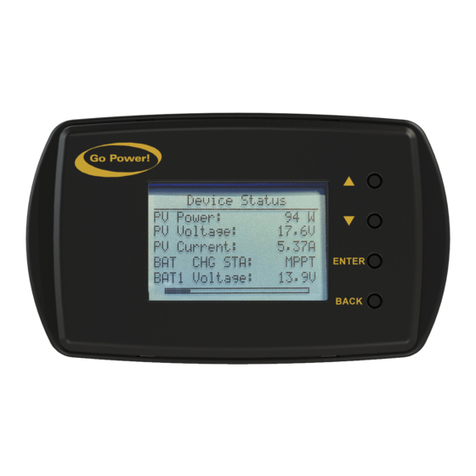
Go Power
Go Power GP-RVC-R User manual

Go Power
Go Power GP-DURALITE-100 User manual
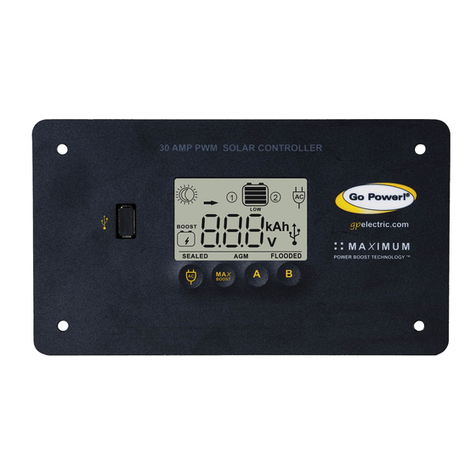
Go Power
Go Power GP-PWM-30-UL User manual
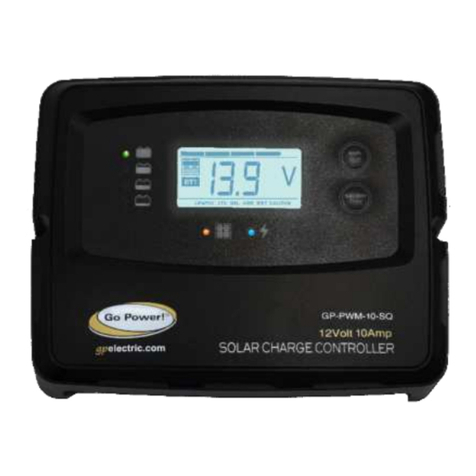
Go Power
Go Power GP-PWM-10-SQ User manual
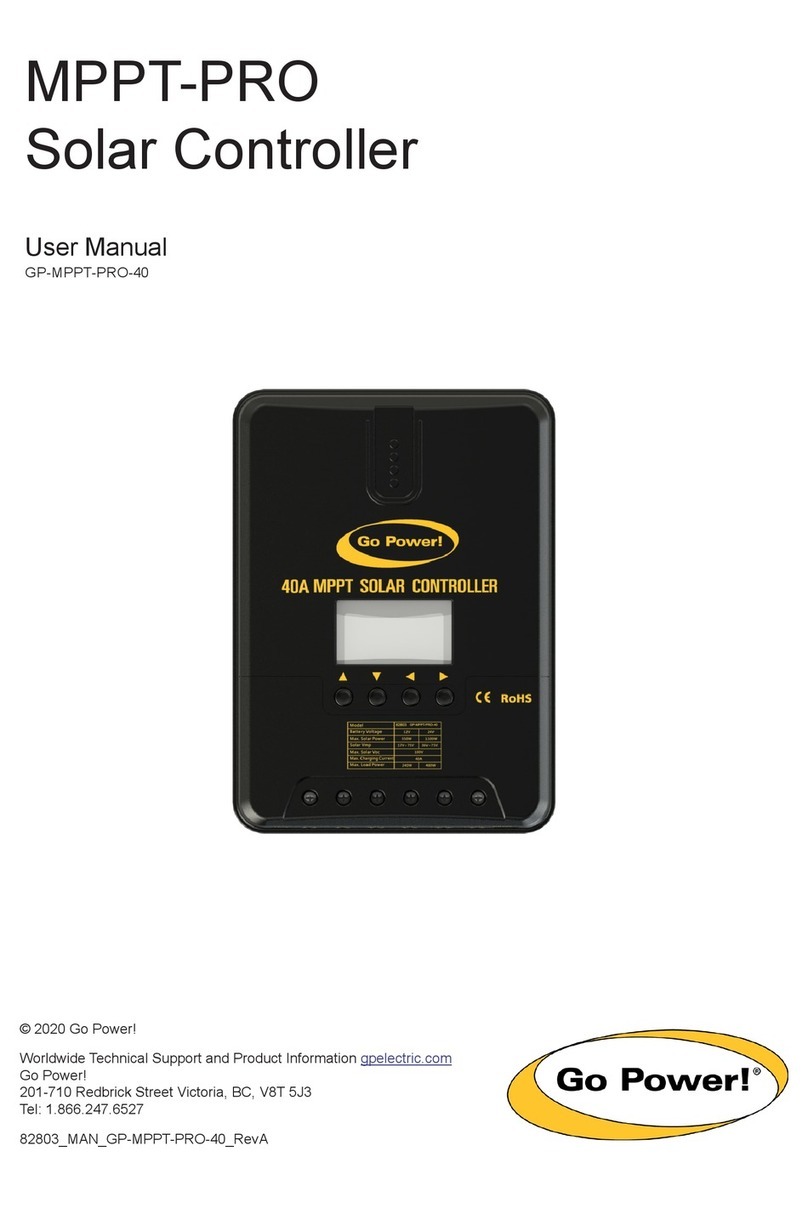
Go Power
Go Power MPPT-PRO User manual
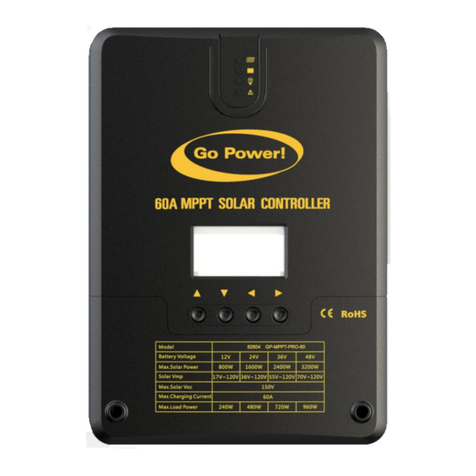
Go Power
Go Power MPPT-PRO Series User manual
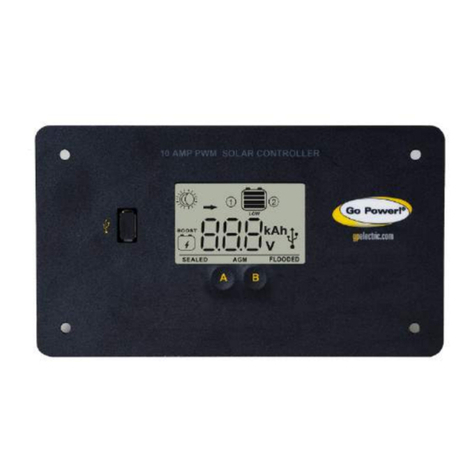
Go Power
Go Power GP-PWM-10-FM User manual
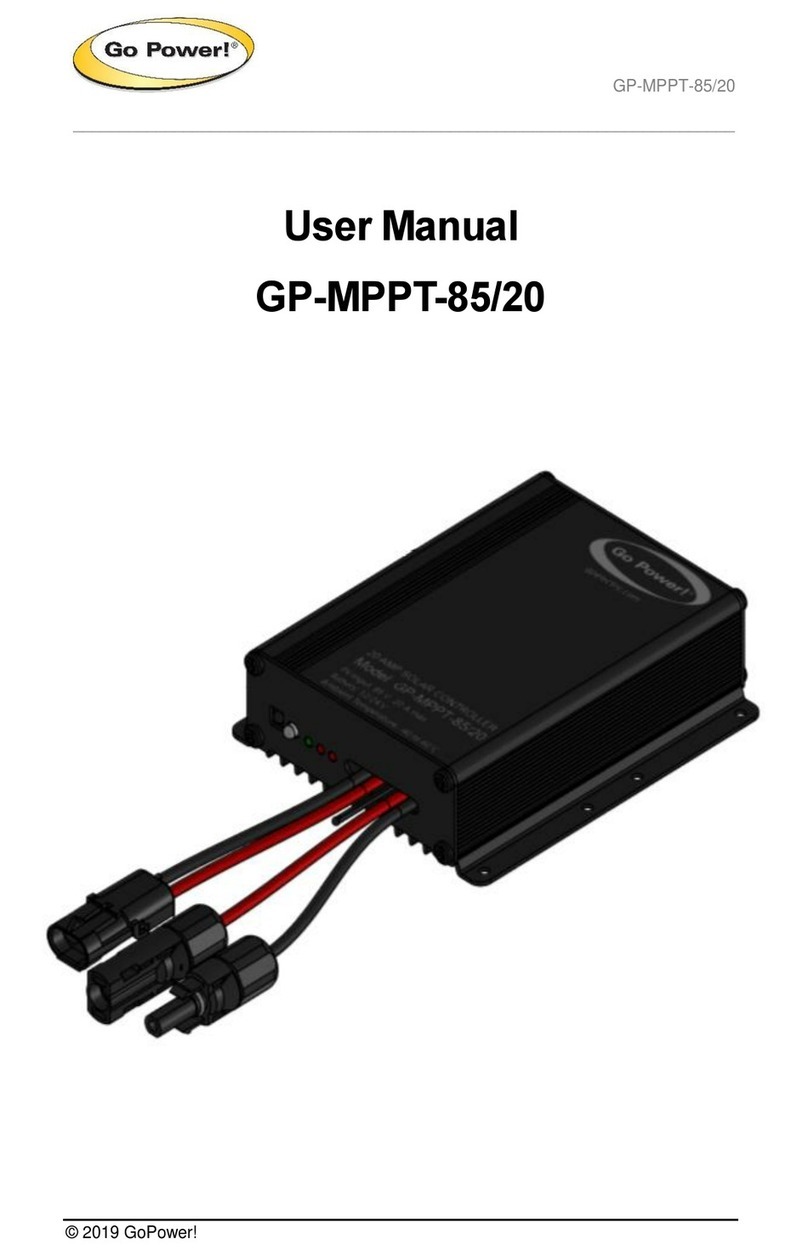
Go Power
Go Power GP-MPPT-85/20 User manual
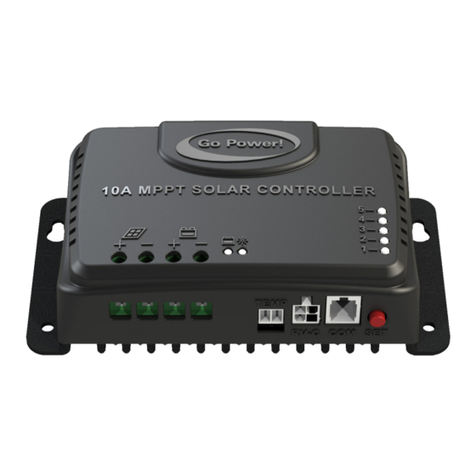
Go Power
Go Power 10 AMP RVC-MPPT User manual
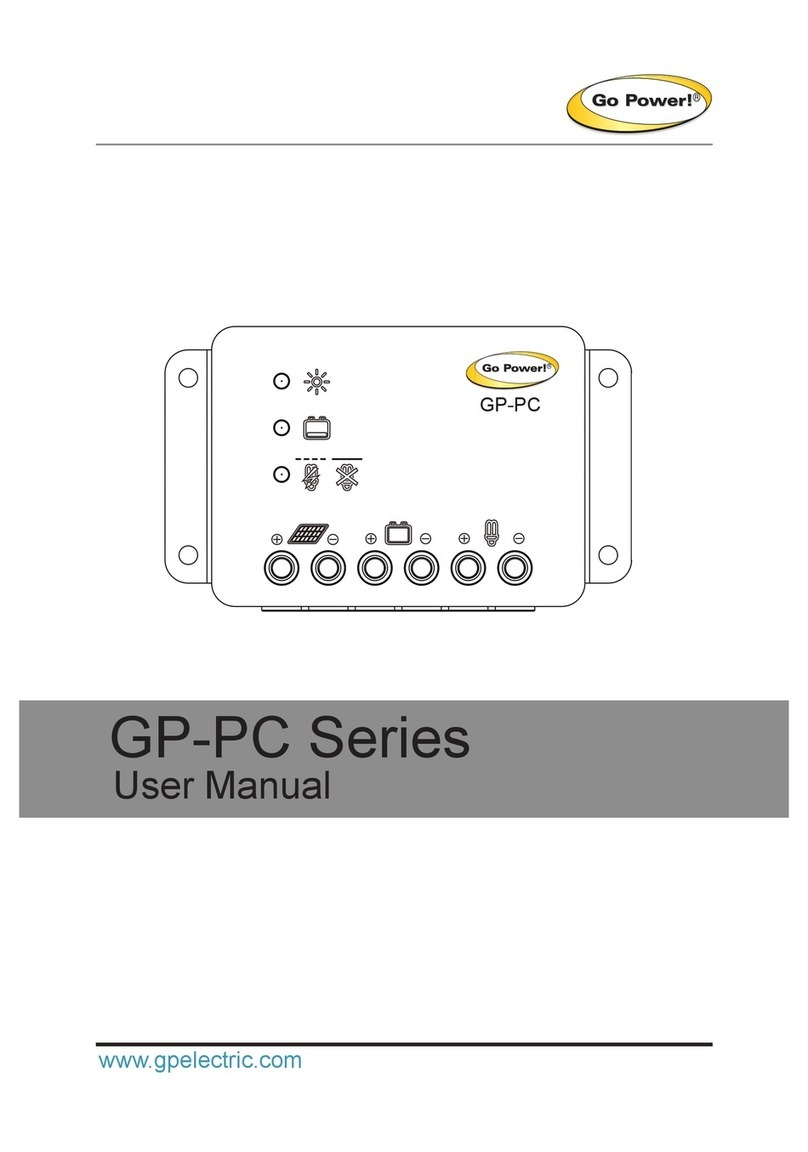
Go Power
Go Power GP-PC Series User manual


